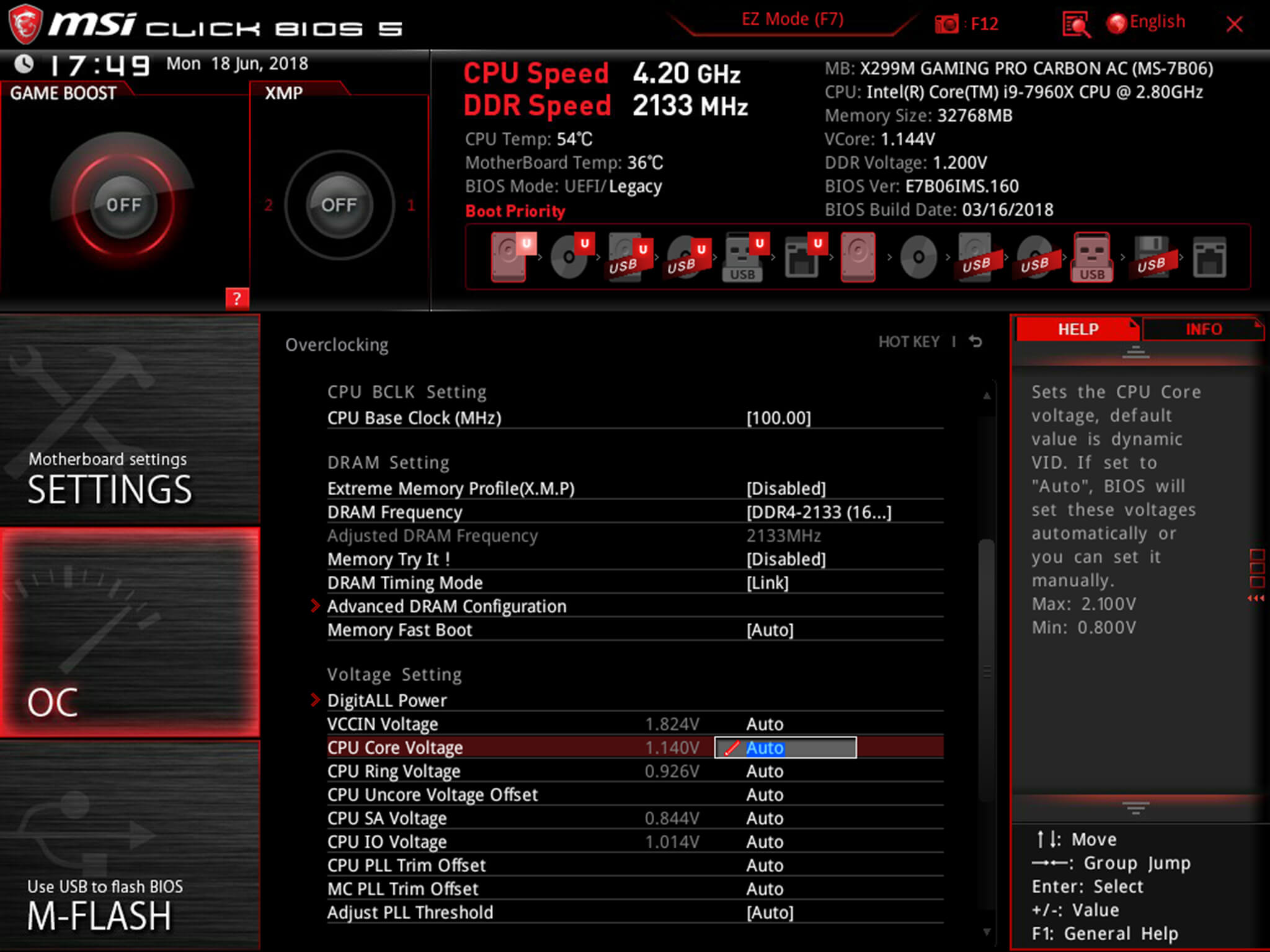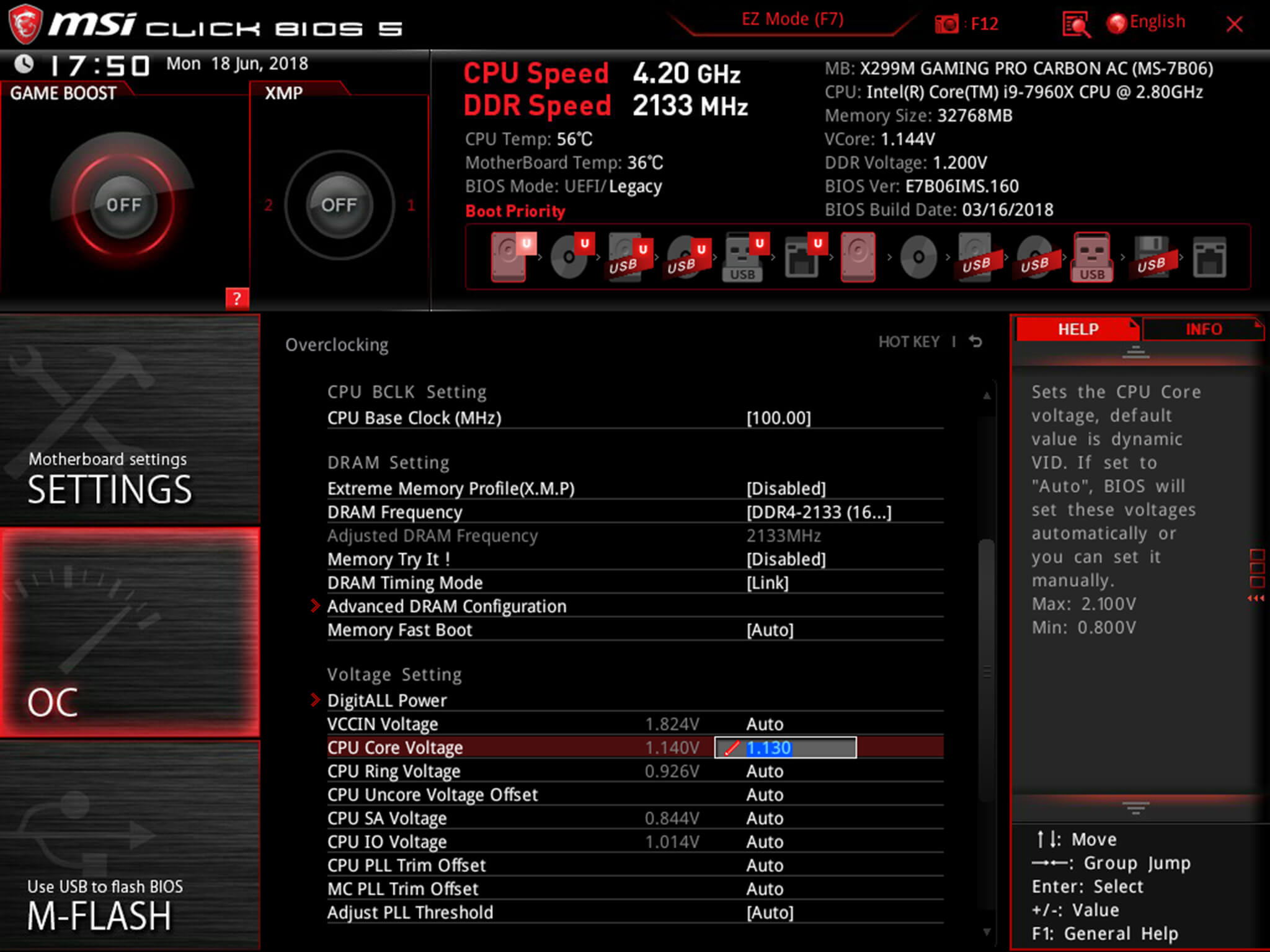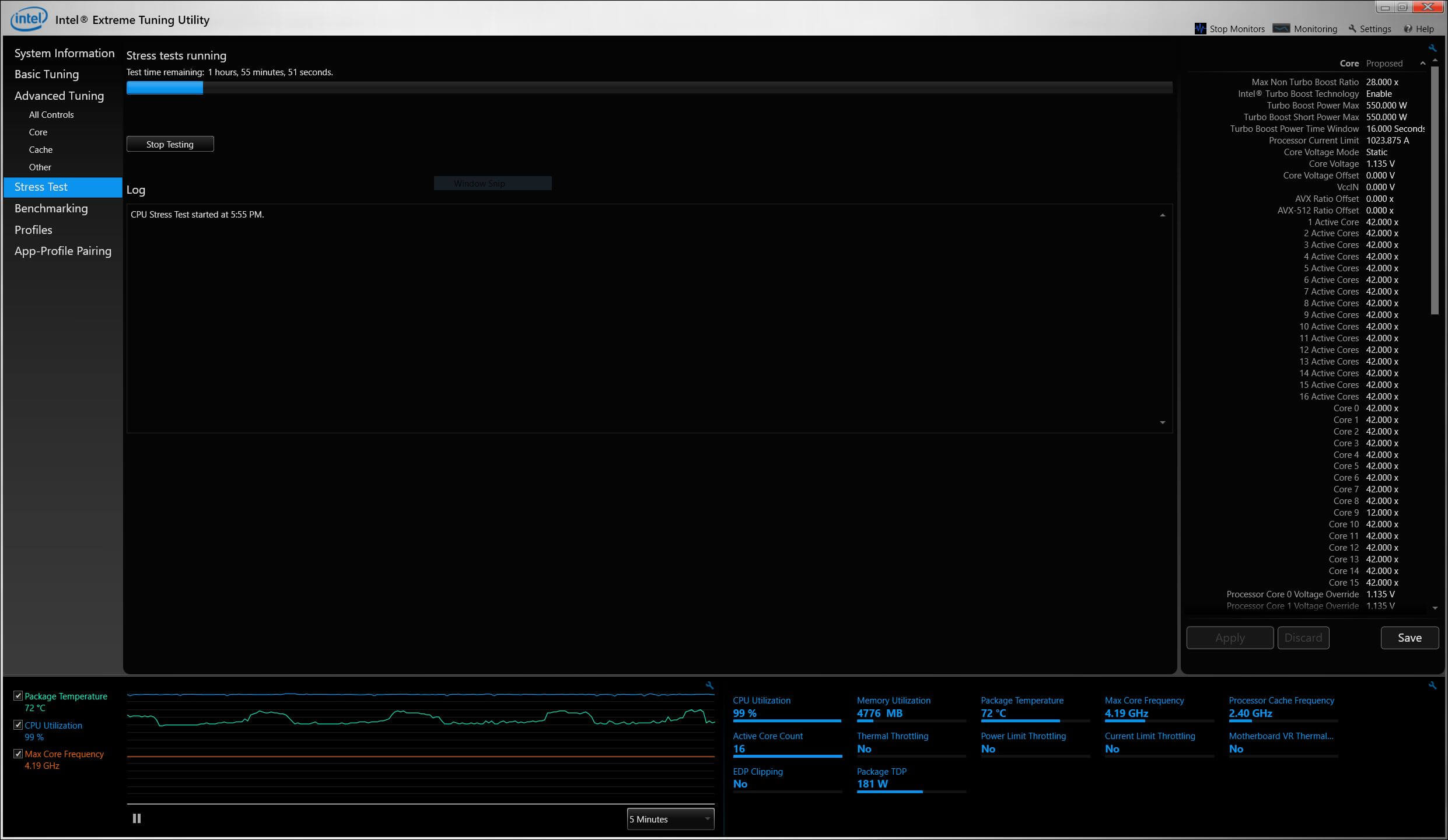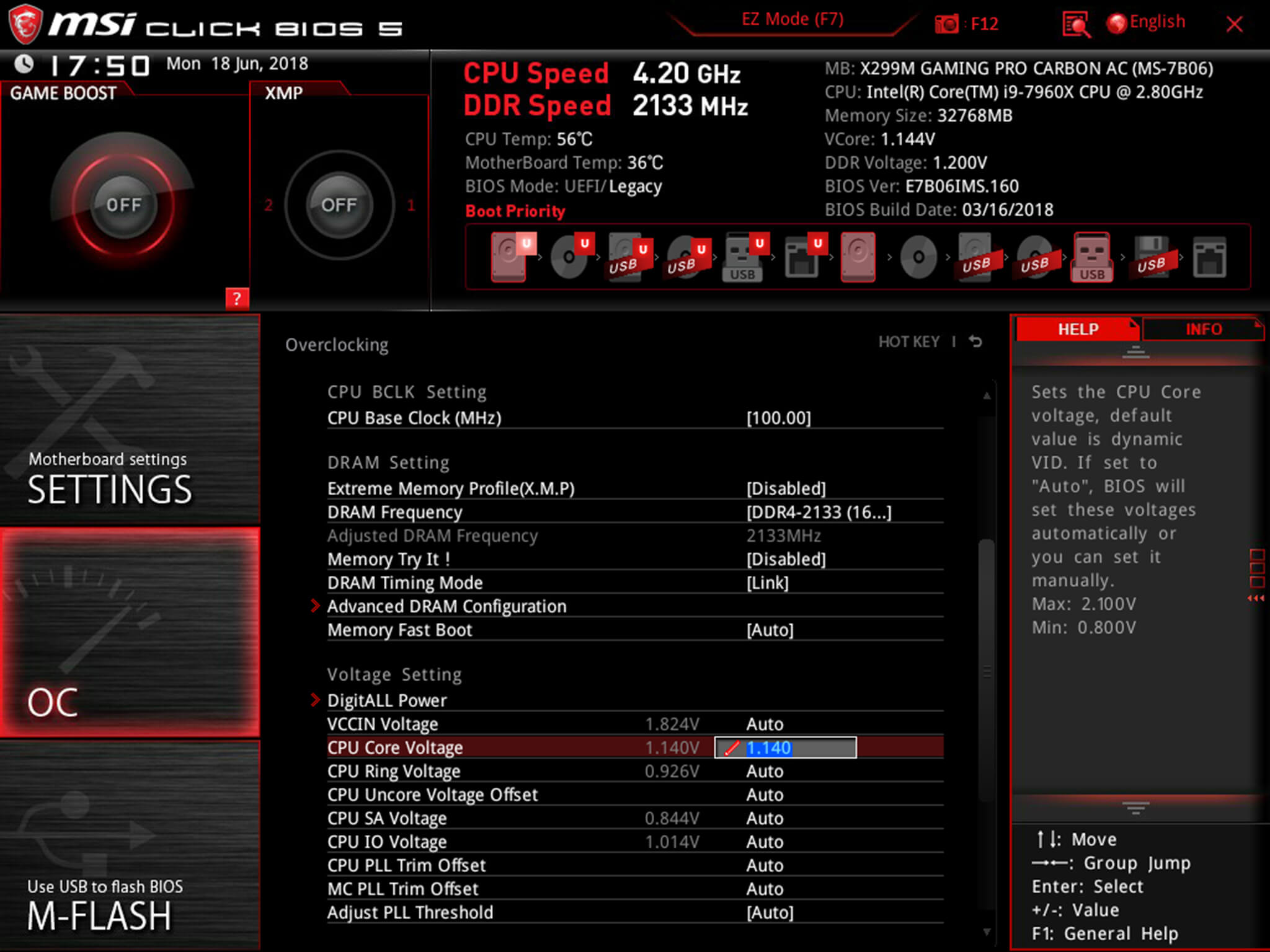The core voltage is different for each processor model, and while all CPUs of the same model have the same VID, not all samples maintain stability at the same clock speeds and Vcore due to slight variations in silicon quality. Every sample of the same CPU model is tested to maintain stability at the default speeds and the VID determined by the manufacturer.
Core voltage typically maintains a constant value while your CPU is in use; however, sometimes under heavy workloads vcore can fluctuate. This is known as Vdroop and can be corrected with load-line calibration. This applies additional voltage as load increases to maintain your CPU's stability.
When it comes to overclocking, you can only push your CPU's frequency so far before your CPU starts to experience instability. Programs might begin to crash or hang up, game performance could suffer or your computer could even fail to boot. This is because your processor isn't getting enough voltage to maintain system stability.
Increasing voltage will allow you to dial in the perfect overclock.
To adjust the voltage, you'll need to boot into your motherboard's BIOS and make adjustments there. The Vcore is expressed as a three decimal value, such as 1.235v. By default, the voltage control is set to auto; this can be overridden by typing in any value. Make sure not to exceed the recommended maximum for your processor.

Before fine-tuning the Vcore, it's important to find a good baseline value for a given speed. This varies from model to model but it can be helpful to read reviews for your CPU, specifically ones that focus on overclocking.
Most publications will list the voltage they required to keep several different speeds stable. Every CPU sample is different and you will need to fine-tune the voltage before calling it done; however, these values do provide a good starting point.

If you boot your machine and don't find any stability issues, then you know it's time to start decreasing the voltage. When overclocking, you want to find the lowest voltage required to maintain stability. More voltage equals more heat and this will allow you to keep temperatures under control.

The safest way to adjust voltage is with increments of .01 volts. Decrease voltage until your computer starts showing signs of instability under load. Use a program like Intel's Extreme Tuning Utility (XTU) or Prime95 to stress test your processor.
If the test fails or crashes, then you need to raise the voltage back up to the previous stable point. For optimal efficiency, you can increase the voltage by .005 instead and again test for stability.

Conversely, if your overclock isn't stable at your baseline voltage, you will then need to increase the voltage until your computer shows no adverse effects and then decrease in increments of .005 to fine tune.

Overclocking is not the only time it can be useful to adjust voltage. As mentioned, higher voltage levels cause your CPU to generate more heat, regardless of frequency. Some CPU samples may have a higher VID than is actually required at the default frequency. Undervolting your processor allows your to maintain stability while decreasing temperatures and extending the life of your processor.
It's a common misconception that disabling Turbo Boost is a more effective substitute for shedding heat. While this does result in decreased temperatures, it is not an alternative as the purpose of undervolting is to maintain the same level of performance while generating less heat. When making adjustments, the same principles apply here as with overclocking, decrease Vcore in increments of .01 and then fine tune with adjustments of .005.
 The Beatles biopic casts all the internet's boyfriends in one movie
The Beatles biopic casts all the internet's boyfriends in one movie
 Midjourney V1 AI video model: Price and how to try it
Midjourney V1 AI video model: Price and how to try it
 Best TCL deal: Save over $700 on the 75
Best TCL deal: Save over $700 on the 75
 TikTok ban has been extended, Trump signs executive order
TikTok ban has been extended, Trump signs executive order
 Researchers map the koala genome in the name of saving the species
Researchers map the koala genome in the name of saving the species
 Trinidad and Tobago vs. Haiti 2025 livestream: Watch Concacaf Gold Cup for free
Trinidad and Tobago vs. Haiti 2025 livestream: Watch Concacaf Gold Cup for free
 NYT Strands hints, answers for June 20
NYT Strands hints, answers for June 20
 Best budget tablet deal: Get the Amazon Fire HD 8 Plus for $55
Best budget tablet deal: Get the Amazon Fire HD 8 Plus for $55
 Netherlands vs. Spain 2025 livestream: Watch UEFA Nations League for free
Netherlands vs. Spain 2025 livestream: Watch UEFA Nations League for free
 Everything you need to know about Prime Day 2025
Everything you need to know about Prime Day 2025
 SpaceX's BFR has a new name. Elon Musk is calling it Starship.
SpaceX's BFR has a new name. Elon Musk is calling it Starship.
 Best TV deal: Save $190 on the Amazon 65
Best TV deal: Save $190 on the Amazon 65
 Best Ninja deal: Save $50 on the FrostVault 45QT cooler
Best Ninja deal: Save $50 on the FrostVault 45QT cooler
 Best Anker charger deal: Take 25% off the Anker MagGo wireless charging station
Best Anker charger deal: Take 25% off the Anker MagGo wireless charging station
 Best Fire Stick deal: Save $20 on Amazon Fire Stick 4K
Best Fire Stick deal: Save $20 on Amazon Fire Stick 4K
 Best Ninja deal: Save $50 on the FrostVault 45QT cooler
Best Ninja deal: Save $50 on the FrostVault 45QT cooler
 Best vacuum deal: Get the Dyson V8 Plus cordless vacuum for $120 off
Best vacuum deal: Get the Dyson V8 Plus cordless vacuum for $120 off
 Best charger deal: Save $18 on Anker 3
Best charger deal: Save $18 on Anker 3
 Amazon Big Spring Sale 2025: Best Apple deals on iPads, MacBooks, and more still live
Amazon Big Spring Sale 2025: Best Apple deals on iPads, MacBooks, and more still live
 Best power station deal: Save $220 on Jackery Explorer 1000 v2
Best power station deal: Save $220 on Jackery Explorer 1000 v2
Michael Cera's Allan is 'Barbie's sly secret weaponThe Black Album by Rowan Ricardo PhillipsTwitter scraps press email's autoInstagram copies another TikTok feature with 'Remix'The Best Christmas Card Ever by Sadie SteinThe Black Album by Rowan Ricardo PhillipsFacebook freezes Venezuela president's page for sharing COVID misinfoExplained: Who's the old lady on the bench in the 'Barbie' movie?Why Tai Chi needs more love from the tech worldPetSafe 5 Meal Pet Feeder review: LowMichael Cera's Allan is 'Barbie's sly secret weaponDarcy vs. Knightley, and Other News by Sadie Stein'Quordle' today: See each 'Quordle' answer and hints for July 21Darcy vs. Knightley, and Other News by Sadie SteinThis Author Hates His Book’s Cover by Sadie SteinWordle today: Here's the answer and hints for July 22Mysterious Skin: The Realia of William Gaddis by Matthew EricksonAmazing Headline Alert by Sadie SteinFirst Position by Yona Zeldis McDonoughThe Carolers by Titi Nguyen HBO Max's 'Somebody Somewhere' review: an uplifting examination of adult friendship Reddit user texts brother mid Disney remixer Pogo under fire for homophobic rant on YouTube Dwayne Johnson and John Krasinski did the Murph Challenge together Google Play Games is now available on PCs Benedict Cumberbatch, IRL superhero, saved a man from four muggers Fan perfectly recreates Tom Holland's photoshoot, gets response from the man himself YouTube Originals scales back as it nears an end Taking a dive with the NYC Freegans How to enable SharePlay on iPhone and iPad How the powerful Tonga volcanic eruption sent enormous pressure waves all around Earth This person's attempt to lie about their love of cars went very wrong, very fast Facebook scraps custom reaction buttons, including rainbow Pride flag Not a single all How to make your Twitter profile picture an NFT The only good thing to come out of Bitcoin is this cat Instagram will now show suspected hate speech lower in your Feed Reese Witherspoon is going to read a CBeebies bedtime story The 'Where are you from?' meme reminds us to look at a map every once in a while Amazon's new app
1.6879s , 10133.359375 kb
Copyright © 2025 Powered by 【Sister Emanuelle】,Co-creation Information Network